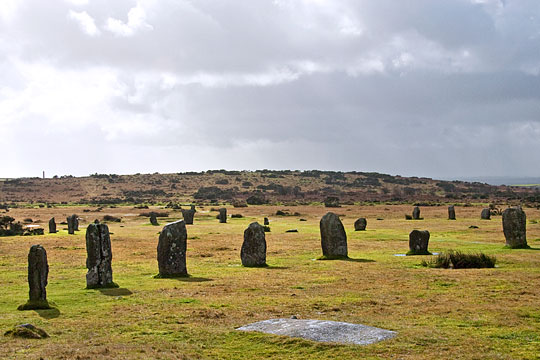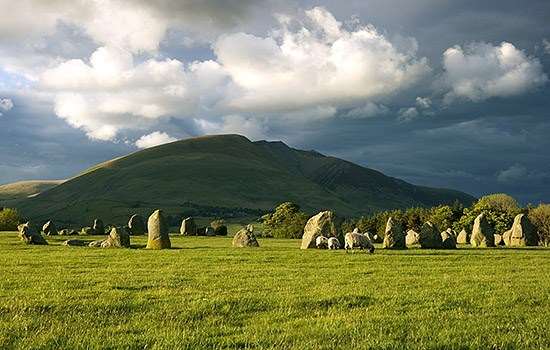History of The Hurlers Stone Circles
Some 150 prehistoric stone circles have been identified in England, of which 16 are to be found on Bodmin Moor, the largest of the Cornish granite uplands. Of these, The Hurlers are the most fascinating.
The close grouping of three Late Neolithic or Early Bronze Age stone circles is extremely rare in England, but a grouping of three such regular circles is unique.

The monument, which was excavated in the 1930s, consists of three adjacent stone circles aligned north-east to south-west. To the west is a pair of outlying upright stones standing close together, known as the Pipers.
Of the northern circle 15 original stones are visible, and excavation revealed the buried holes for a further ten, now represented by marker stones. The regular spacing of the stones suggests there would have been five more, giving 30 in all.
A strip of granite paving, found in excavation, ran between this and the central circle.
The central circle, the best preserved of the three, has 14 original stones and 14 markers. All the stones were hammered smooth, and the chippings were deposited nearby. The southern circle, which has not been excavated, is the least well preserved: it has nine original stones of which seven have fallen.
Stone robbing has damaged all the circles to some extent, while the introduction of cattle on to Bodmin Moor has resulted in many of the stones falling over: cows use them as scratching posts, eroding the ground and undermining them.
The small pits visible within the southern and central circles, and a slight bank crossing the central circle, are the remains of post-medieval tin mining.
Description
The monument forms one element in an extensive grouping of later Neolithic and Bronze Age ceremonial and funerary monuments on this part of Bodmin Moor, and the circles are directly aligned with some of these.
The axis through the centres of the two northern circles aligns directly on the massive Rillaton Barrow, visible on the skyline to the north-east, while the axis of the southern pair of circles in turn aligns directly with a prehistoric round cairn to the south-west.
Another line at right angles to this axis through the central circle takes in another stone circle, an embanked avenue and a stone row. Such circles are likely to have had considerable ritual importance for the societies that used them.
A local legend identifies The Hurlers as men who were turned to stone for playing the ancient game of hurling on a Sunday. The two isolated stones of the Pipers are said to be the figures of two men who played tunes on a Sunday and suffered the same fate.
Further Reading
Burl, A, The Stone Circles of Britain, Ireland and Brittany (New Haven and London, 2000)
Dymond, CW, The Hurlers: Cornish Stone Circles, Institute of Geomantic Research Occasional Papers, 8 (Cambridge, 1977)


